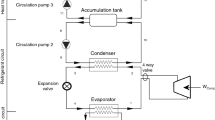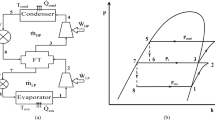Abstract
A comparative study is performed to investigate the improved heat-driven refrigeration systems. The systems use a low-temperature heat source to produce low-temperature cooling (− 55 °C). The base system consisted of a hybrid GAX (HGAX) cycle and a Rankine cycle. Three major features for the HGAX cycle are proposed in four configurations to reduce the high temperature of the compressed fluid exiting the compressor. The operating parameters of the systems having the maximum exergy efficiency are computed, and the corresponding performance parameters are applied in all configurations. The results show that the best configuration that has higher exergy efficiency is the one utilizing two compressors in the HGAX cycle. For the heat source temperature of 133.5 °C, this configuration has 34.7% higher energy utilization factor, 33% higher exergy efficiency, 11% lower total product cost, and 28% lower circulating cooling water of the cooling tower than the base system.








Similar content being viewed by others
Notes
Same as cooling temperature in references [3, 20].
Same as hot water input in reference [12].
Abbreviations
- AHE:
-
Auxiliary heat exchanger
- AGAX:
-
Absorber GAX
- \(\dot{C}\) :
-
Cost rate ($/s)
- COP:
-
Coefficient of performance
- CRF:
-
Capital recovery factor
- DGAX:
-
Desorber GAX
- e:
-
Efficiency
- \(\dot{E}\) :
-
Exergy rate (kW)
- EI:
-
Energy index
- EUF:
-
Energy utilization factor
- GAX:
-
Generator–absorber heat exchange (already defined)
- h :
-
Enthalpy
- HGAX:
-
Hybrid GAX
- i :
-
Interest rate
- \(\dot{m}\) :
-
Mass flow rate (kg/s)
- n :
-
System life (year)
- P :
-
Pressure (kPa)
- \(\dot{Q}\) :
-
Heat transfer rate (kW)
- RC:
-
Rankine cycle
- RHX:
-
Reheated heat exchanger
- T :
-
Temperature (°C)
- \(\dot{W}\) :
-
Power rate (kW)
- \(\dot{Z}\) :
-
Investment cost ($/s)
- \(\varphi\) :
-
Maintenance factor
- \(\tau\) :
-
Annual operation hours
- a:
-
Absorber
- ava:
-
Available
- B:
-
Boiler
- Com:
-
Compressor
- CT:
-
Cooling tower
- CW:
-
Circulating water in the cooling tower
- eva:
-
Evaporator
- ex:
-
Exergy
- G:
-
Generator
- geo:
-
Geothermal
- HS:
-
Heat source
- hw:
-
Hot water
- in:
-
Input
- out:
-
Output
- P:
-
Product
- tur:
-
Turbine
- req:
-
Requirement
References
Akbari Kordlar M, Mahmoudi SMS (2017) Exergeoconomic analysis and optimization of a novel cogeneration system producing power and refrigeration. Energy Convers Manage 134:208–220
Anand S, Gupta A, Tyagi SK (2014) J Therm Anal Calorim 117:1453. https://doi.org/10.1007/s10973-014-3889-x
Baek JS, Groll EA, Lawless PB (2005) Theoretical performance of transcritical carbon dioxide cycle with two-stage compression and intercooling. Proc Inst Mech Eng Part E: J Process Mech 219:187–195
Chemical Engineering Plant Cost Index (Cepci) (2018). http://www.cheresources.com/invision/topic/21446-chemical-engineering-plant-cost-index-cepci/. Accessed 13 May 2018
Du S, Wang RZ, Chen X (2017) Analysis on maximum internal heat recovery of a mass-coupled two stage ammonia water absorption refrigeration system. Energy 133:822–831
Garimella S, Brown AM, Krishna A (2011) Waste heat driven absorption/vapor- compression cascade refrigeration system for megawatt scale high-flux, low temperature cooling. Int J Refrig 34:1776–1785
Ifaei P, Rashidi J, Yoo Ch (2016) Thermoeconomic and environmental analyses of a low water consumption combined steam power plant and refrigeration chillers – part 1: energy and economic modelling and analysis. Energy Convers Manage 123:610–624
Kang Y, Hong H, Park KS (2004) Performance analysis of advanced hybrid GAX cycles: HGAX. Int J Refrig 27:42–448
Kumar AR, Udayakumar M (2007) Simulation studies on GAX absorption compression cooler. Energy Convers Manage 48:2604–2610
Lee T, Liu CH, Chen TW (2006) Thermodynamic analysis of optimal condensing temperature of cascade-condenser in CO2/NH3 cascade refrigeration systems. Int J Refrig 29:1100–1108
Mehr AS, Zare V, Mahmoudi SMS (2013) Standard GAX versus hybrid GAX absorption refrigeration cycle: from the view point of thermoeconomics. Energy Convers Manage 76:68–82
Mohammadi SMH, Ameri M (2014) Energy and Exergy comparison of a cascade air conditioning system using different cooling strategies. Int J Refrig 41:1–13
Mohammadi K, Saghafifar M, McGowan JG, Powell K (2019) Thermo-economic analysis of a novel hybrid multigeneration system based on an integrated triple effect refrigeration system for production of power and refrigeration. J Cleaner Prod. https://doi.org/10.1016/j.jclepro.2019.117912
Mousavi SA, Mehrpooya M (2019) A comprehensive exergy-based evaluation on cascade absorption-compression refrigeration system for low temperature applications - exergy, exergoeconomic, and exergoenvironmental assessments. J Cleaner Prod 246. https://doi.org/10.1016/j.jclepro.2019.119005
Parikhani T, Azariyan H, Behrad R, Ghaebi H, Jannatkhah J (2020) Thermodynamic and thermoeconomic analysis of a novel ammonia-water mixture combined cooling, heating, and power (CCHP) cycle. Renew Energy 145:1158–1175
Rezayan O, Behbahaninia A (2011) Thermoeconomic optimization and exergy analysis of CO2/NH3 cascade refrigeration systems. Energy 36(2):888–895
Rogdakis ED, Antonopoulos KA (1992) Performance of a low-temperature NH3–H2O absorption refrigeration system. Energy 17:477–484
Saidi MH, Sajadi B, Sayyadi P (2011) Energy consumption criteria and labeling program of wet cooling towers in Iran. Energy Build 43:2712–2717
Sayyadi H, Nejatolahi M (2011) Thermodynamic and thermoeconomic optimization of a cooling tower-assisted ground source heat pump. Geothermics 40:221–232
Seyfouri Z, Ameri M, Mehrabian MA (2018) Exergo-economic analysis of a low-temperature geothermal-fed combined cooling and power system. Appl Therm Eng 145:528–540
Shi Y, Wang Q, Hong D (2016) Thermodynamic analysis of a novel GAX absorption refrigeration cycle. Int J Hydrogen Energy 42:1–8
Xu Z, Wang R (2016) Absorption refrigeration cycles: categorized based on the cycle construction. Int J Refrig 62:114–136
Author information
Authors and Affiliations
Corresponding author
Rights and permissions
About this article
Cite this article
Seyfouri, Z., Ameri, M. & Mehrabian, M.A. Energy, Exergy and Economic Analyses of Different Configurations for a Combined HGAX/ORC Cooling System. Iran J Sci Technol Trans Mech Eng 46, 733–744 (2022). https://doi.org/10.1007/s40997-022-00497-x
Received:
Accepted:
Published:
Issue Date:
DOI: https://doi.org/10.1007/s40997-022-00497-x




